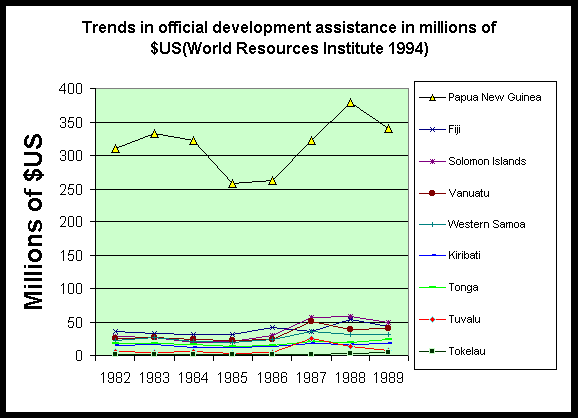Dependency in the Pacific Islands
Foreign Aid
Pacific Island countries receive more aid per capita than any other category of developing countries. In 1993 they received about $650 million of official assistance with Australia providing about one half. PNG absorbed about 45% of the aid. Excluding PNG, each person received an average of US$204 of aid in 1993 (Fairbairn 1994). This is unevenly distributed between the countries with the smallest countries receiving the highest funding per capita. Aid dependence in GDP terms ranged from Fiji’s 4% and PNG’s 7% to 18-22% for the Solomon Islands, Vanuatu and Tonga and 32-38% for Samoa and Micronesia. Many of the smaller Pacific island countries receive 100% of their public sector investment from aid.
Foreign aid and remittances to the Pacific island countries have encouraged government structures and consumption patterns that are unsustainable by the island resources. Massive imports of food and fuel are required to maintain the people of the Pacific islands. Many of the islands could, if they chose to, increase food production and processing to meet their own needs. Instead, often at the instigation of aid agencies and governments, they grow low to medium value crops for export; a process that is causing further environmental problems.
 |
This situation is a precarious strategy. As populations continue to expand, jobs, land, and local food production have not been able to keep pace. Most Pacific island governments are already having trouble meeting recurring costs, even with large aid budgets. Added strains of unemployment and hunger are steadily eroding social and environmental conditions. This, in turn has a negative impact on tourism, currently the largest income earner for several Pacific island countries.
About 45% of the official aid took the form of technical assistance (TA). This has created a dependency on outside experts to gather information and solve difficult technical and social problems. The use of foreign experts as long term TAs creates a situation where local counterparts relax and let the experts do all the work. Short term TA projects brings in experts to solve immediate problems, but because the solutions are done in a hurry, they seldom have any lasting impact and are rarely followed up.
The lack of co-ordination between aid donors is a well recognized problem. Annual dialogues between aid donors and the South Pacific Forum have not made much operational difference. ADB, now a leading donor in several Pacific island countries, now included donor-recipient consultations to improve its support of structural adjustment programs.
ADB’s evaluation of its own projects in Pacific island countries rated less than half as "generally successful", and 22% as complete failures (Hughes 1996). Aid donors, seeing development funds effecting little positive change, are less willing to expand assistance. Following the break-up of the Warsaw Pact many sources of external funds - the Governments of Canada, New Zealand, the United Kingdom and the United States) have been withdrawing support from the Pacific. The intention of donors is that the area should become financially self-supporting as soon as possible. France and Japan, however, are increasing their assistance to the area.
Since the UNCED, there has been an increase in sustainability conditions attached to funding from the World Bank and the Asian Development Bank, and many bilateral and multi-lateral funding agencies. This improves government’s awareness - if not it’s determination - to develop sustainability policy.
Aid donors wholesale environmentally oriented aid to the Pacific islands through the South Pacific Regional Environment Programme. SPREP, in turn, is supposed to retail these moneys as projects within their 22 member countries. Although aid donors have allocated large sums of money to SPREP for environmental programs, SPREP has had considerable difficulty retailing its funds.
Funds set up specifically to help small island countries adopt and action Agenda 21 have had little impact. For reasons not made clear, SPREP never adopted Agenda 21 as a central theme for achieving sustainability. Agenda 21 is a unifying concept and a set of useful guidelines for sustainable development and environmental protection. Since it was officially adopted by many Pacific Island Governments, it is odd that SPREP and the Pacific island governments have ignored it.
